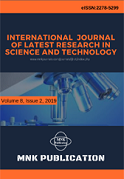DOI:10.29111/ijlrst ISRA Impact Factor:3.35, Peer-reviewed, Open-access Journal
Research Paper Open Access
International Journal of Latest Research in Science and Technology Vol.3 Issue 4, pp 65-71,Year 2014
Correspondence should be addressed to :
Received : 15 August 2014; Accepted : 26 August 2014 ; Published : 31 August 2014

| Download | 125 |
|---|---|
| View | 177 |
| Article No. | 10356 |
Hand gesture segmentation is a key step for gesture recognition. Based on the construction of a new color space of skin model, a new dynamic-thresholding segmentation approach named Adaptive Threshold Segmentation Algorithm (ATSA) was further developed and segmentation effect evaluation was conducted. Some images of hand gesture were processed by using ATSA and the Fixed Threshold Segmentation (FTS) algorithm as well as the Similarity algorithm of Skin Color (SSC). Comparing with FTS and SSC algorithms, The ATSA is experimentally demonstrated that, the segmentation results have a less brightness impact, a lower redundancy rate, a lower rate of false alarm and missing, and a higher integrity rate.
Copyright © 2014 Mei Wang et al. This is an open access article distributed under the Creative Commons Attribution 4.0 International (CC BY 4.0) license which permits unrestricted use, distribution, and reproduction in any medium, provided the original work is properly cited.
Mei Wang, Jzau-Sheng Lin, Zhou Xing Fu,Guo Qing Meng , " Gesture Segmentation Using An Adaptive Threshold Algorithm ", International Journal of Latest Research in Science and Technology . Vol. 3, Issue 4, pp 65-71 , 2014

MNK Publication was founded in 2012 to upholder revolutionary ideas that would advance the research and practice of business and management. Today, we comply with to advance fresh thinking in latest scientific fields where we think we can make a real difference and growth now also including medical and social care, education,management and engineering.

We offers several opportunities for partnership and tie-up with individual, corporate and organizational level. We are working on the open access platform. Editors, authors, readers, librarians and conference organizer can work together. We are giving open opportunities to all. Our team is always willing to work and collaborate to promote open access publication.

Our Journals provide one of the strongest International open access platform for research communities. Our conference proceeding services provide conference organizers a privileged platform for publishing extended conference papers as journal publications. It is deliberated to disseminate scientific research and to establish long term International collaborations and partnerships with academic communities and conference organizers.